Community Tech & Social Infrastructure
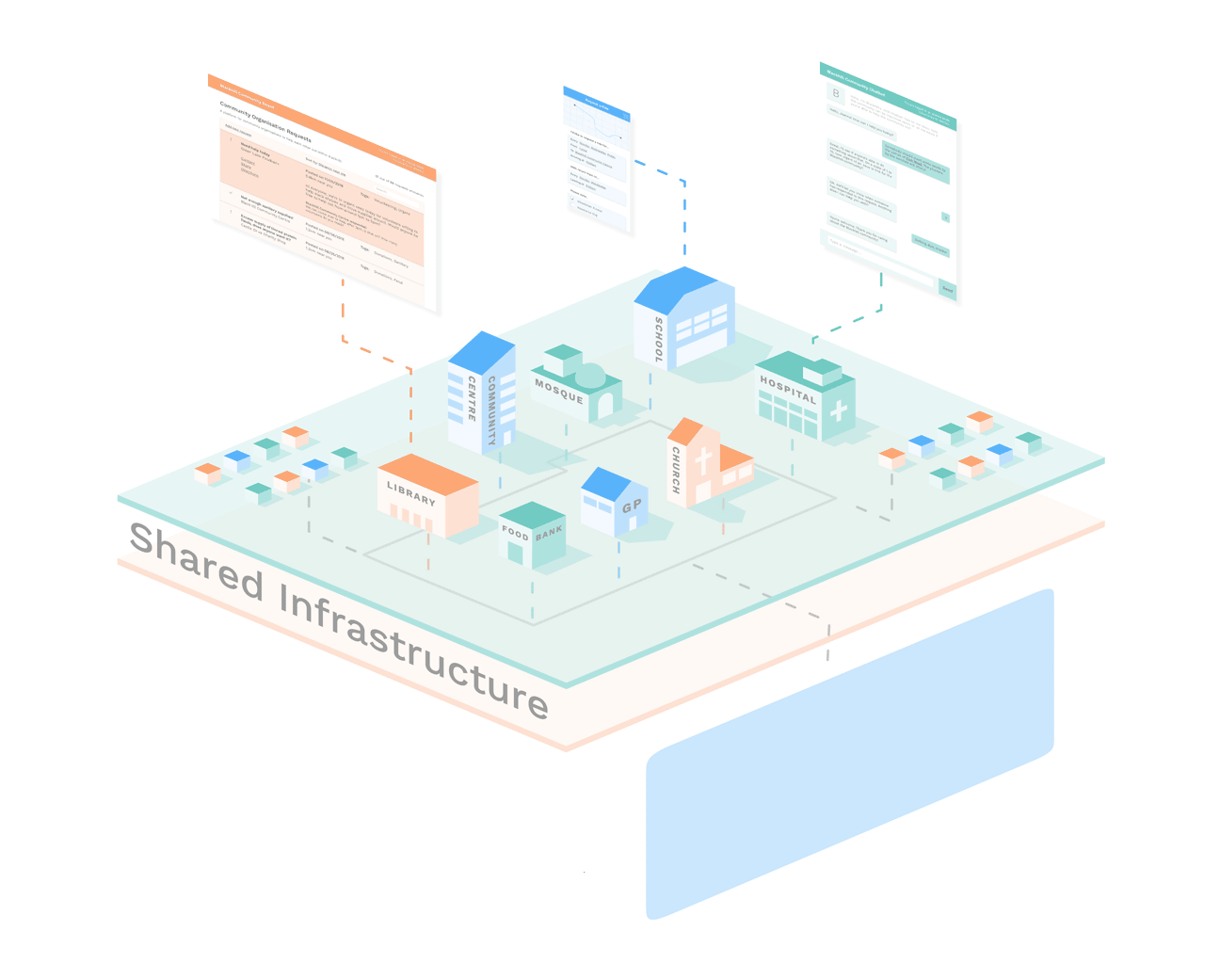
Last year we held a small event with Civil Society Futures, based on this blog post. We wanted to explore what “Community As Platform” could look like, primarily because we were by concerned two things:
- The ownership of local digital infrastructure being run entirely on corporate platforms who amass profit at scale, who are extractive in their behaviour, and are having cumulative affects on our communities.
- The unrealised potential to more effectively use digital to connect up existing social and relational infrastructure through “connecting the system to more of itself.”
Now is the time
After that first event I felt a bit flummoxed. With small civil society organisations who attended the event we mapped out the different types of activity they were doing, and the kinds of tools they were using. You’ll see that it’s what you’d expect – Facebook, Whatsapp etc. We undertook some further user research, going out in to community organisations to understand their common activities, all with the aim of seeing whether Community As Platform had viability. I’ll come to that research shortly.
But what’s interesting is that last Autumn the project came to a stand still.
Perhaps it was because Doteveryone chose to prioritise other things, or because at that point nobody seemed able to imagine a world where Facebook and Google weren’t the go-to things for everything (they are “free” and convenient after all). 12 months on and it feels like people are much more ready to face a reality where our infrastructure being owned by corporates creates a real vulnerability in our social infrastructure.

Where we got to last year
From our user research with small civil society groups we understood that they would benefit from:
- Less duplication of effort
- Better use of data
- More collaboration and sharing of assets
- Greater digital understanding (not feeling overwhelmed by digital and knowing where to start — this is not the same as needing digital skills)
- Redesigning or sticking to their focus on user and community needs not funders needs
Some of the challenges we heard:
- People’s lives don’t only exist in services — nobody quite understands how to support more informal activity
- Activity in civil society is often seen as about giving voice, campaigning, activism etc and therefore the everyday can be neglected, and it’s the every day that is the foundation of social infrastructure
- We also realised that nobody has done any really good user research on the activity of civil society organisations — or they hadn’t back then that we could find.
We spoke to and spent time with 20 different small civil society organisations and here are some common needs from our user research:
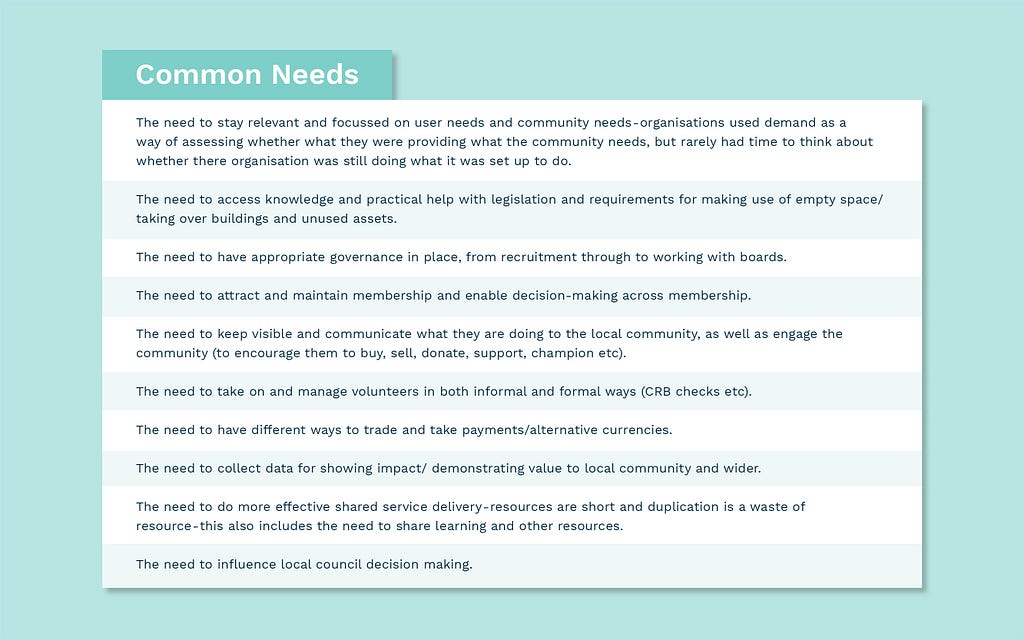
How could community tech play a role in strengthening social infrastructure?
Alongside doing user research we also did some speculative design work, creating some scenario narratives based on what we’d heard and designing community tech systems to respond to them. We imagined the following:
Food Banks
The food banks in nearby local communities coordinate around supplies and volunteer support, to make the most of what’s available. Food bank organisers, volunteers and staff of local shops can post requests for items or for help, and information about supplies. This enables real time balancing of supply and demand of both food and other items, and of labour. Contributors can add comments or ask for clarifications, or indicate when they are getting involved to help out. Once a need or issue is met, the food bank who posted the issue can mark it as resolved.
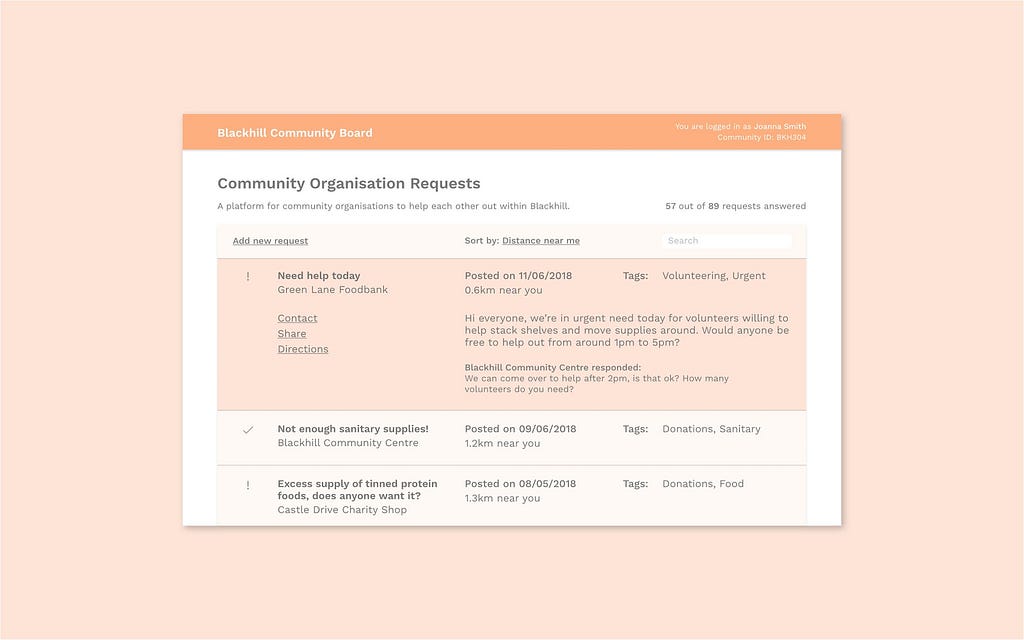
What about the tech?
The underlying technology enables this through connecting people and organisations around an area, with confidence in who is posting. Because the system isn’t targeted at food bank organisers only, or specific to a certain supermarket chain, it enables coordination of diverse participants around a broader shared interest. It also gathers information about supply and demand which can inform planning and organisation by the community, for instance organising regular working parties for times of high labour demand, or spotting trends in need ahead of time so that requests for donations can be made in advance.
This shared collective intelligence would be much harder to derive from the disparate records of person to person messaging systems or a disorganised chatroom log.
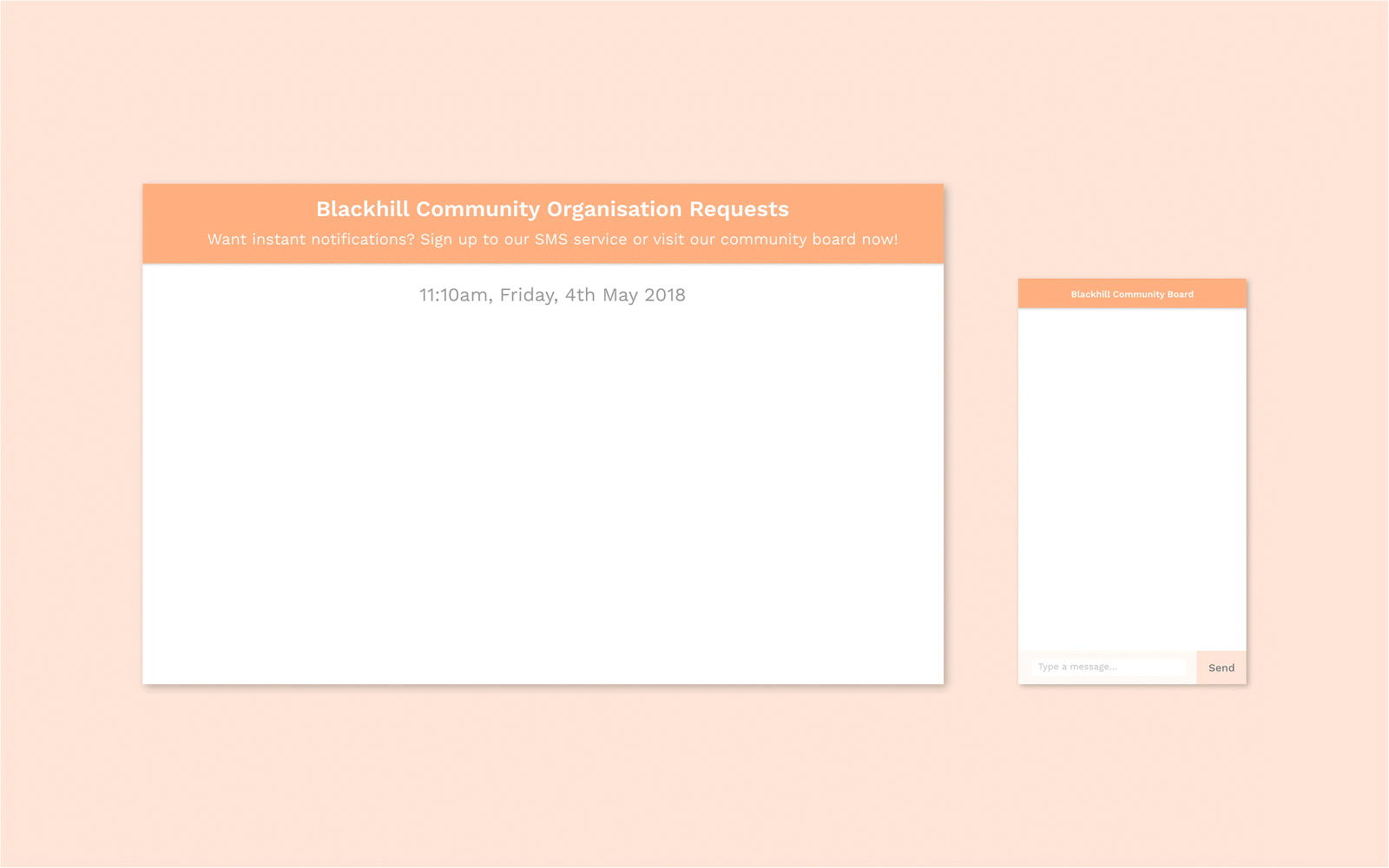
Community travel
In this system, community members can request a ride or regular rides, to enable greater mobility and overcome gaps in transport infrastructure. Volunteer drivers and community groups see a list of posted journey requests, and can indicate which they can take on. Coordinators can see what journey requests are not being met by volunteers and can allocate a paid service as a last resort.
Because transport cuts across local boundaries, it’s important that both riders and drivers can coordinate across what might otherwise be distinct hyperlocal areas. Unlike commercial rideshare services, a community transport service supports requests such as the need for wheelchair transport, or that the rider has an assistance dog or is hard of hearing. For some riders, a regular driver may be beneficial so they can build trust and a more social relationship.
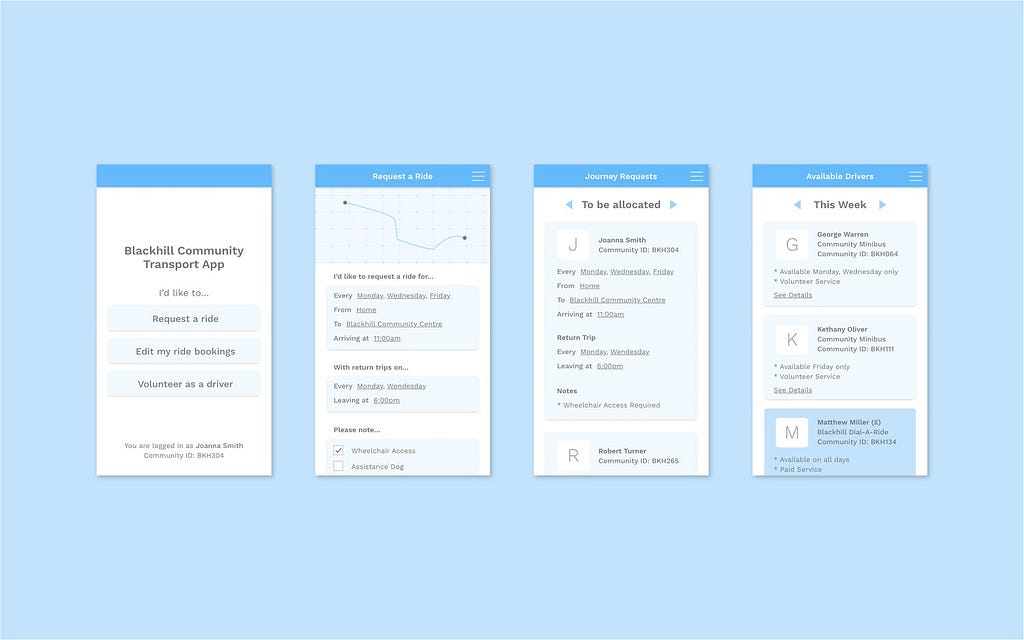
Travel needs like these demand good levels of trust. The community system allows only authorised drivers to access and volunteer for ride requests, so that whatever local system of checks (drivers licence, suitable insured vehicle, criminal records checks, etc) can be integrated.
Community ‘somebody should’ board
Many issues in a local area don’t easily fall within the remit of local public services or specific voluntary groups. They are cross-cutting problems, hard to categorise and may not be significant enough to merit taking up the time of scarce public resource. However, it is useful to have ways to gather issues, enable volunteers or organisations to spot opportunities to help, or to surface complex and important needs which require greater coordination and effort.
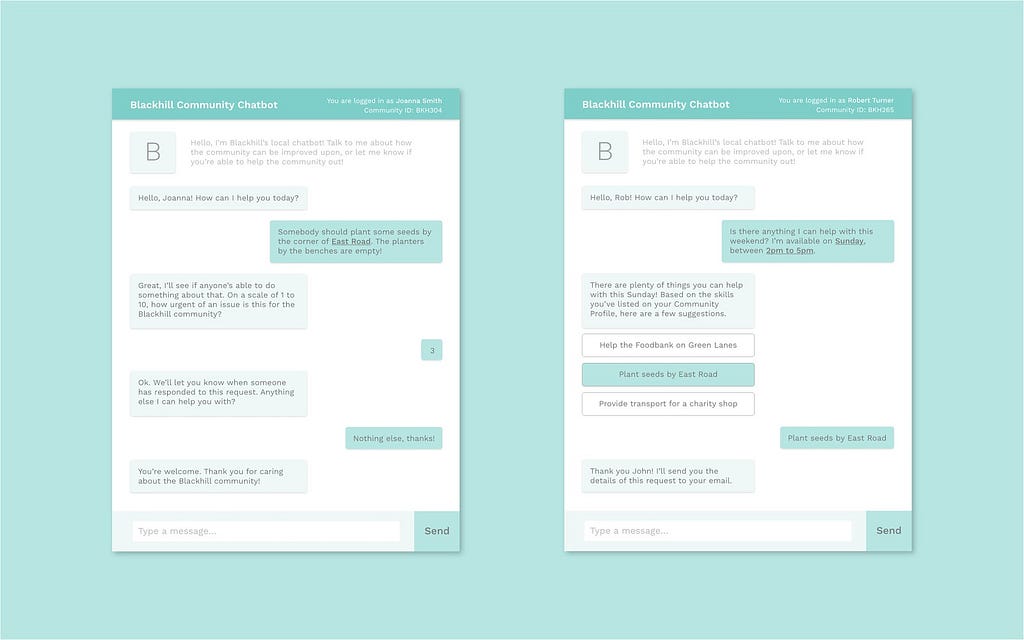
A web notice board where issues can be posted, and ticked off as volunteers address them, can be helpful to coordinate needs and effort across a local area. We prototyped a mobile chat interface, as it’s likely problems will be spotted by community members on the go, and a chat system is more responsive and interactive. The illustrations show someone posting a problem or issue that could be tackled — in this case a small thing which could improve the quality of a local place, and someone else with some time to spare being able to find a task they can help with which they are interested and able to undertake. The feedback loop of knowing the work you are volunteering for will be appreciated — as it’s addressing a problem another local person has identified — reinforces engagement with the system.
Somebody Should exists as a thing in Liverpool already (and we think it is great), however it isn’t accessible or appropriate for everyone as it is on github, which we recognise is a workaround because there’s no other platform.
Why is this better as community tech?
Commercial drivers are unlikely to deliver such a service, or if they did would be focussed on pushing tasks to affiliated companies, or gathering community profile data for other purposes. The information from such a system can drive community insights around common problem areas or complex needs which are not being met, which can be prioritised by local public services, community groups and businesses.
This information can be filtered by place or type or time — the access to the data for the community in a form which means insights can be found, which are relevant and appropriate for the local community (not mixed up in ‘national trends’ or only presented through limited screens) gives power to the community in a way that national or international commercial services are unlikely to do.
What does community tech afford?
Through this work we identified why community tech is important in these contexts
- Governance — how disputes are resolved can be appropriate for the community in question
- The values embedded in the rules of the tech, or codes of conduct, can reflect community values
- Corporate priorities, or algorithmic decisions, won’t take down some content (e.g. breast feeding content is often taken off Facebook, but could be part of valuable community information provision)
- Community tech can be used to organise around protesting/supplementing state/commercial outsourced services — it can be harder to do on local government platforms, or in some cases commercial ones
- Priorities are aligned with the platform for feature development
- You don’t need a commercially interesting or scalable business model (or there’s no business model available at scale) — there isn’t a business model that relies on gathering data for uncertain purpose
- Open APIs and open standards for data formats, code, interfaces can be required, which makes interoperability easier, enables greater community empowerment through access to information and the creation of collective intelligence
- There is a more neutral environment with different expectations to commercial platforms, and less extractive qualities
And the value of shared or common infrastructure?
- It can reduce risk — fewer places holding data etc, if you have shared infrastructure, than hundreds of tiny services
- It affords new explorations for different ways of doing privacy and identity
- It’s easier to support than many tiny services
- It facilitates more coordination and resilience
- It can build greater connections between activities and services
- It helps build collective / local intelligence and resilience — spotting opportunities and challenges
- It means you can gather data at a level and of a type which can be used for community information and planning — local data for local people
- It facilitates collective knowledge building — documenting how people solve problems is useful for future communities
What next?
Since doing this work last year there are several initiatives now looking at this (if you know more then get in touch) — these include the research work that CAST is doing with IVAR (they are looking for people to fill in their survey) and the work that Doteveryone has been doing with Snook and the Wellcome Trust (blog post coming later this week).
Strengthening social infrastructure was always the purpose of the Digital Society strand of work at Doteveryone(“strengthening and protecting what matters most”) and as we try to encourage a more responsible tech industry, we’d do well to focus as much effort on ensuring our social infrastructure isn’t entirely owned or completely displaced in the meantime.
Thank you to Laura James and Josh Kwan for working on this with me.
Community Tech & Social Infrastructure was originally published in Doteveryone on Medium, where people are continuing the conversation by highlighting and responding to this story.